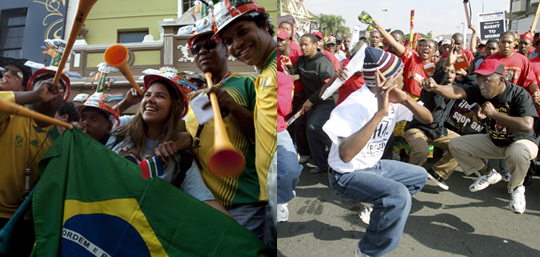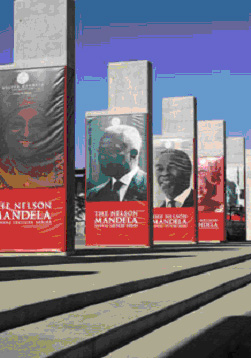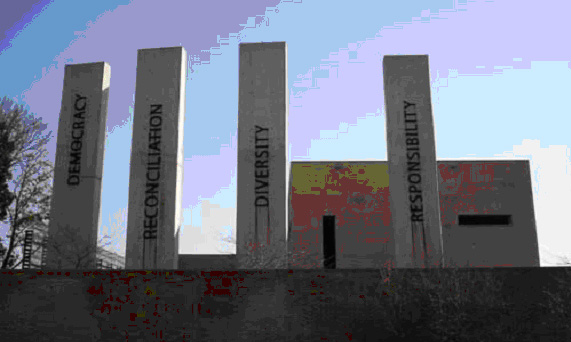
| introduction |
| bright future |
| fostering cohesion | ||
coming together to do our bit to foster social cohesion |
||
 |
||
Promoting social development and social cohesion is a political imperative in South Africa. It is part and parcel of the post-apartheid order, which has consciously embraced the ideal of social cohesion through a number of programmes, initiatives and processes at various levels of government but also through the efforts of business, labour, civil society and citizens in general. Take government, for example… Government has had to confront the fundamental issue of social cohesion in promoting national unity, dealing with diverse social identities and preserving the multiple cultural heritages of South Africans. Government efforts to address social cohesion can be seen in elections processes (including voter education), in awareness raising and education campaigns, and in various policy choices, programmes, networks and partnerships. Government has also sought to facilitate philanthropy and corporate social investment, and has worked with civil society organisations to promote cohesion. In 2006, national government through the Forum of South African Directors-General (FOSAD), undertook to implement a social cohesion strategy ahead of the 2010 FIFA World Cup. This involved a set of specific government interventions and partnerships with communities and other stakeholders such as organs of civil society and corporate South Africa. Government role players included the Office of Gender Equality in the Presidency, the Departments of Labour, Social Development, and Sports and Recreation. Programmes focusing on patriotism, tolerance, and national identity include campaigns on national symbols (including sport symbols and emblems), the national pledge as well as the Bill of Responsibilities as part of promoting the South African national identity. There are community education, leadership and training programmes and national and provincial workshops and indabas. A process of social dialogue has been undertaken to facilitate dialogue about the significance of national days in promoting national identity and social cohesion. Part of the social cohesion strategy involves establishing new infrastructure such as fan parks, supporters clubs and public viewing areas and upgrading existing sports, arts and culture infrastructure. Government has also pledged to establish a research programme to monitor and evaluate social cohesion continuously.1 Within the context of Gauteng, social cohesion is envisioned as a central part of the plans of the Province to build Gauteng as a globally competitive city-region. The province’s overall strategic focus is geared specifically toward social cohesion through programmes and policies which are intended to reverse the spatial, economic and social legacies of apartheid. A key pillar of the social cohesion strategy is the reversal of spatial apartheid centrally responsible for social divisions among black and white South Africans. Under this strategy there has been a policy shift toward improved quality of housing, of quality of life and of access to economic opportunities. Some examples are the Urban Renewal Programme, the 20 Townships Programme and the Mixed Income Housing Programme which look to building sustainable human settlements. The 20 Townships Programme has targeted 20 townships for major improvements such as tarring roads, putting up street lamps and developing residential centers such as shopping malls.2 The Gauteng Safety Strategy serves as an example of a provincial government strategy to promote cohesion and social capital. Social relations amongst South Africans are strained by high levels of crime and violence. The Gauteng Safety Strategy is a crime-prevention strategy which is intended to bring together community members from Community Policing Forums and volunteer patrollers with the Department of Community Safety and the South African Police Service (SAPS). This initiative combines law enforcement with the involvement of communities at local level to ensure their own safety.3 Part of the Safety Strategy’s social cohesion function is intended to be a breaking down of historical mistrust between and amongst historically divided communities as well as between communities and the police. One initiative of note is the City of Johannesburg’s Migrant Help Desk. The Migrant Help Desk is intended to address the plight of foreign nationals experiencing xenophobia in the city. It works to provide information and advice about government services for migrants and refugees, coordinates the city’s support for migrants and looks to educate citizens of the city about xenophobia. The desk works in partnership with several leading civil society organisations (CSOs) such as Black Sash, Lawyers for Human Rights and Jesuit Refugee Services. While the desk was unable to prevent or predict the dramatic wave of xenophobic violence which began in Alexandra township in May 2008, it was a key role player in helping coordinate the province’s response to the violence. Other government efforts to weave together a cohesive social fabric include the development or promotion of urban regeneration initiatives which look to cultivate a common memory of the past and particularly between people of different social identities to help communities come to terms with a past of collective sustained violence. One key example in the Gauteng city-region is the Greater Kliptown Regeneration Development in the historically rich area of Soweto, with its focus anchored on the Walter Sisulu Square of Dedication. The Square is the historical site of the signing of the Freedom Charter in 1955, seen by many as the cornerstone of South Africa’s struggle for freedom and democracy and the foundation of the country’s 1996 Constitution. |
||
 |
||
Downloaded from http://www.nelsonmandela.org The Apartheid Museum at Gold Reef City in Johannesburg is an attempt to commemorate South Africa’s complex and troubled history through documentation of the rise and fall of apartheid. Located on the outskirts of Johannesburg, the museum is intended to serve as a potent reminder of the dynamics of political and social struggle and actively introduce museum-going to a sector of the population historically culturally marginalised. |
||
 |
||
Civil society has worked to address issues of social justice in the city-region (e.g. the Coalition Against Xenophobia, Save our SABC Coalition and the Social Cohesion Dialogues implemented in various communities by the Nelson Mandela Foundation). Take for example, the work of a private charitable foundation, the Nelson Mandela Foundation (NMF), in combating xenophobia and intolerance at community level in selected provinces in South Africa. The increasing prevalence of xenophobia in South Africa is a direct challenge to social cohesion and accordingly social justice in South Africa. In May 2008 a wave of xenophobic violence took place in Alexandra township in Gauteng province against African non-nationals, which quickly spread to other parts of the country. Between 11 and 25 May 2008, 62 people, the majority African non-nationals, died in Johannesburg, Cape Town, Durban and to a lesser extent, in parts of the Free State and Eastern Cape. The xenophobic attacks caused death, injury and massive loss of property, but these were only the most visible consequences. It left deep psychic scars on the victims of the violence who experienced severe psycho-social trauma as a result of the attacks and feared returning to the communities which had expelled them. In response to the urgent need for reconciliation, the NMF launched the Programme to Promote Social Cohesion which consists of a series of ‘Community Conversations’ or dialogues in communities where xenophobic violence has occurred. This programme is undertaken in partnership with other CSOs, faith-based groups and community leaders to promote healing and reconciliation in communities4. Civil society is generally robust and inventive. It is able to use legal strategies and political mobilization to bear on issues of local development and to challenge government. Resistance to government policies have sprung from the grassroots in the form of social movements and community activist coalitions such as the Anti-Privatisation Forum (APF) and the Soweto Electricity Crisis Committee (SECC). Both movements were formed in response to a perceived failure by government to provide poor South Africans with basic rights such as affordable water and electricity. The Treatment Action Campaign (TAC) is a civil society organisation that uses the discourse of human and socio-economic rights to campaign for affordable treatment for people with HIV/AIDS. By combining legal and political modes of action, it has managed to address a range of HIV/AIDS related issues at local, national and international levels and achieved several political and legal victories in the struggle to make access to treatment for HIV/AIDS widespread and affordable. Other sectorally specific CSOs include the Education Rights Project (ERP), Landless Peoples Movement (LPM), Jubilee SA, Youth for Work and the Palestine Solidarity Committee.5 Some recent civil society community activist coalitions include the Coalition Against Xenophobia (a broad coalition of civil society organisations, social movements, community activists and concerned individuals protesting and working against xenophobia) and the Save the SABC Coalition, a consortium of independent producer organisations, trade unions, academics, independent experts, civil society organisations and NGOs such as the Freedom of Expression Institute (FXI) and Media Institute of Southern Africa (MISA).
1 See Cornelissen, S. (2008) Scripting the nation: sport, mega-events, foreign policy and state-building in post-apartheid South Africa in 'Sport in Society', 11:4, pp 481-493 2 See Harrison, P. Todes, A. and Watson, V. (2008) 'Planning and transformation: learning from the post-apartheid experience'. New York: Routledge. 3 'Joburg City Safety Strategy Executive Summary' downloadable at http://www. joburg-archive.co.za 4 http://www.nelsonmandela.org 5 Ballard, R. Valodia, I. and Habib, A. (2006) 'Voices of Protest: Social movements in post-apartheid South Africa'. Durban University of KwaZulu Natal Press. |
||
